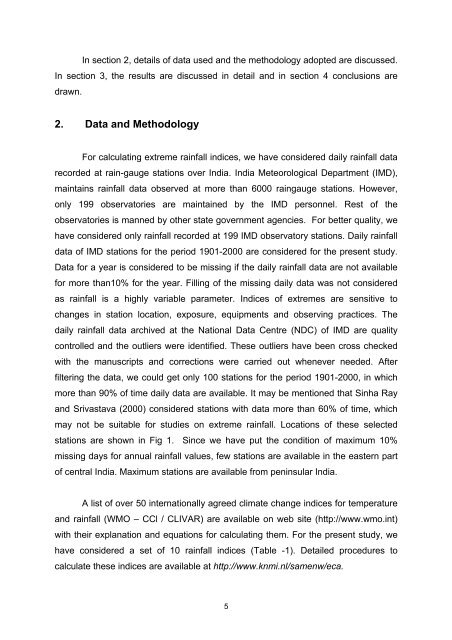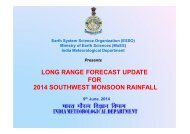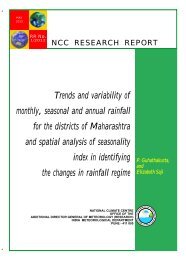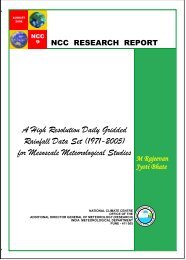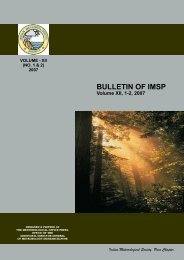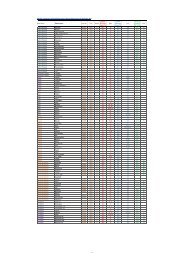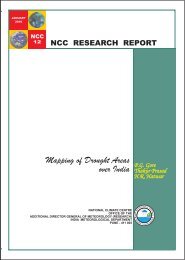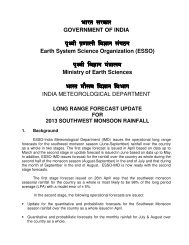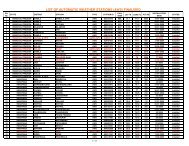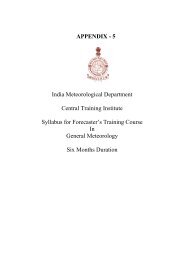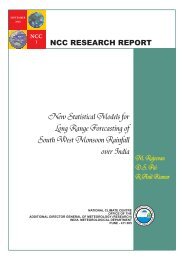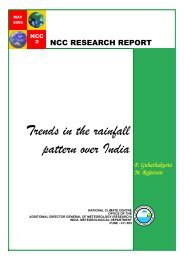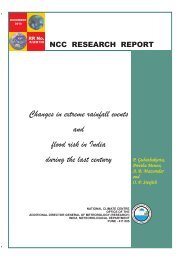Trends in Precipitation Extremes over India - (IMD), Pune
Trends in Precipitation Extremes over India - (IMD), Pune
Trends in Precipitation Extremes over India - (IMD), Pune
You also want an ePaper? Increase the reach of your titles
YUMPU automatically turns print PDFs into web optimized ePapers that Google loves.
In section 2, details of data used and the methodology adopted are discussed.In section 3, the results are discussed <strong>in</strong> detail and <strong>in</strong> section 4 conclusions aredrawn.2. Data and MethodologyFor calculat<strong>in</strong>g extreme ra<strong>in</strong>fall <strong>in</strong>dices, we have considered daily ra<strong>in</strong>fall datarecorded at ra<strong>in</strong>-gauge stations <strong>over</strong> <strong>India</strong>. <strong>India</strong> Meteorological Department (<strong>IMD</strong>),ma<strong>in</strong>ta<strong>in</strong>s ra<strong>in</strong>fall data observed at more than 6000 ra<strong>in</strong>gauge stations. However,only 199 observatories are ma<strong>in</strong>ta<strong>in</strong>ed by the <strong>IMD</strong> personnel. Rest of theobservatories is manned by other state g<strong>over</strong>nment agencies. For better quality, wehave considered only ra<strong>in</strong>fall recorded at 199 <strong>IMD</strong> observatory stations. Daily ra<strong>in</strong>falldata of <strong>IMD</strong> stations for the period 1901-2000 are considered for the present study.Data for a year is considered to be miss<strong>in</strong>g if the daily ra<strong>in</strong>fall data are not availablefor more than10% for the year. Fill<strong>in</strong>g of the miss<strong>in</strong>g daily data was not consideredas ra<strong>in</strong>fall is a highly variable parameter. Indices of extremes are sensitive tochanges <strong>in</strong> station location, exposure, equipments and observ<strong>in</strong>g practices. Thedaily ra<strong>in</strong>fall data archived at the National Data Centre (NDC) of <strong>IMD</strong> are qualitycontrolled and the outliers were identified. These outliers have been cross checkedwith the manuscripts and corrections were carried out whenever needed. Afterfilter<strong>in</strong>g the data, we could get only 100 stations for the period 1901-2000, <strong>in</strong> whichmore than 90% of time daily data are available. It may be mentioned that S<strong>in</strong>ha Rayand Srivastava (2000) considered stations with data more than 60% of time, whichmay not be suitable for studies on extreme ra<strong>in</strong>fall. Locations of these selectedstations are shown <strong>in</strong> Fig 1. S<strong>in</strong>ce we have put the condition of maximum 10%miss<strong>in</strong>g days for annual ra<strong>in</strong>fall values, few stations are available <strong>in</strong> the eastern partof central <strong>India</strong>. Maximum stations are available from pen<strong>in</strong>sular <strong>India</strong>.A list of <strong>over</strong> 50 <strong>in</strong>ternationally agreed climate change <strong>in</strong>dices for temperatureand ra<strong>in</strong>fall (WMO – CCl / CLIVAR) are available on web site (http://www.wmo.<strong>in</strong>t)with their explanation and equations for calculat<strong>in</strong>g them. For the present study, wehave considered a set of 10 ra<strong>in</strong>fall <strong>in</strong>dices (Table -1). Detailed procedures tocalculate these <strong>in</strong>dices are available at http://www.knmi.nl/samenw/eca.5


